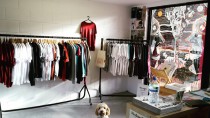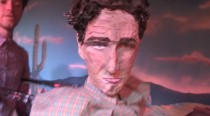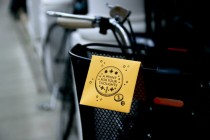Typical expectations of an art school degree show are that Fine Art will have the depth, and design will have the impact. Additionally, in recent years much discussion and energy on the part of the Design Council, amongst others, has been concerned with graduates employability and being tooled up for work. Certainly there is always keen industry desire to unearth the next wave of showstopping talent in design, illustration and photography from the Visual Communication department. Glasgow has certainly produced a high calibre crop this year, but the show doesn’t necessarily come across as a ‘come and get me’ plea to design agencies, illustration agents and commissioners. Instead it’s a much more self-determined affair, an altogether quieter show, cloth-bound, with subtle and crafted works in place of any superficial sheen.
As Andy Stark, the photography tutor puts it, several of his graduates have successfully ‘transcended art school’. Whilst it’s typical to see students taking on ‘issues’, this isn’t ‘docu-porn’ – here are people who have gone into unchartered territory, lived and breathed their subject matter and thought about relevant ways in which they might affect some change.
Go and seek out James Bettney’s work. Having heard about the plight of Nepalese widows, ostracised by their society on account of long-held reincarnation beliefs, he worked tirelessly to record their lives. These are more than just moving portraits – in themseleves first rate – but complete life stories meticulously recorded and translated, and presented here in a beautiful artists book. He’s in the process of setting up a charity and a website which will be at mutunepal.com

In a similar vein, Sarah Fishlock has worked closely with the Scottish Middle Eastern Council telling highly personal stories of isolated Iraqi’s living in Glasgow, stuck in a cultural and physical no mans’s land after working for the British MOD. Shrouded by official secrecy that prevents their faces being photographed, Fishlock instead trains her camera on incidental details that tell you much about the transient state of the lives she’s documenting.
Alec Farmer’s slick graphic work belies much earthier concerns and practical ideas. His ‘Co-ordinate’ project is one of those devastatingly simple but brilliant ideas harnessing off the shelf technology. He uses reskinned Flickr Maps as the basis for connecting world issues with problem solvers and designers, and although hypothetical it’s easy to see it taking off.
Lu Sisi (another graduate familiar to CenSta members) is a motion graphic exponent who has carved out his own niche through an exploration of the merging of sound and image. His main piece is a tribute to the Heidelberg press in the art school caseroom, which he brings alive with it’s own clanking, whirring sounds boiled down into a sort of breakbeat soundtrack for his stop motion animation. (Industry watchers should note that he recently won an New York Festival Gold, where he was entered into a professional category by mistake!).
Robb Hetherington illustration show is sublime. I initially thought it was graphics, such is the attention to typographic craft and his exploration of the printed medium. He’s reset Samuel Beckett’s ‘Krapp’s Last Tape’, his work responding to and translating Beckett’s ideas, produced as one-off monoprints. Made with an innovative technique blending black ink and golden-yellow varnish on perspex plates, each piece is singular and unique, an artwork rather than something set for reproduction. On an adjacent table a monitor showing a Beckett film is placed face down on a scanner, and new ‘translations’ of it – distorted black shapes and scan lines, are pumped out of a printer.

Sebastian Kalvik has an assured maturity about his work, an understanding of classic typography and layout with the conceptual ability to push projects. I’m making it sound dull, but it’s not, his ‘Cultural Cartographies’ and Scott vs Amundsen books are a joy, and will provoke severe designer envy.

Oliver Pitt. Illustration. I’ve used the word sublime already, and I’m not even sure how to categorise this work. Beguiling? Whetever it is it keeps drawing you back in though. And I want to own some of it. I’m also sure I’ll be seeing more of it commissioned. Tutor Dan Williams says that Pitt has ‘created his own visual language… a spiritual space’ and that makes sense when you’re in front of these largely mono works which seem to oscillate,
and describe entirely foreign shapes, objects and areas.

There’s almost too much to mention in detail, so here’s a few more in summary:
Dean Pauley ‘s delicately crafted manuscripts of of spam email;

Walter Hamilton’s ‘Last’ books – brick like documents of the soon to be demolished Foulis building;

Eva Dolgyra’s monoprints;

Rory Hamilton’s holographic type experiments;
Tau Siroko’s – Intertextual newspapers / format posters;
Lynsey Marshall’s HD films, scripted in collaboration with Louise Welsh.
–
Thanks to Steve Rigley, Andy Stark, Dan Williams, Edwin Pickstone, Kerry Aylin, Mark Baines, and various students
for letting me in and around on the day.
–
City Night Preview tonight – Thursday 9 June
Glasgow School of Art Degree Show 2011 | gsa.ac.uk for further details.
Open: 11-18 June 2011.
Sat/Sun: 10am – 5pm
Mon – Thu: 10am – 9pm
Fri 17th June: 10am – 7pm
















Comments